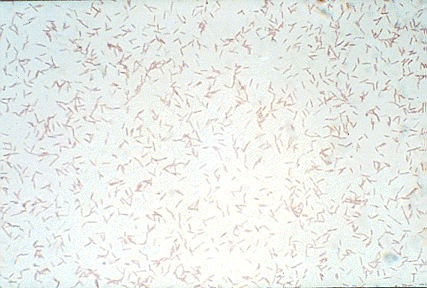LEGIONELLA
LEGIONELLA
(under the microscope)
 The first discovery of bacteria from genus Legionella came in 1976 when an outbreak of pneumonia at
an American Legion convention led to 29 deaths. The causative agent, what would come to be known as
Legionella pneumophila, was isolated and given its own genus. The organisms classified in this
genus are Gram-negative bacteria that are considered intracellular parasites. They grow well on buffered
charcoal yeast agar, but it takes about five days to get sufficient growth. When grown on this medium,
Legionella colonies appear off-white in color and circular in shape.
Laboratory identification can also include microscopic examination in conjunction with a direct flourescent
antibody (DFA) test. Direct specimens of Legionella do not stain well with a Gram-stain.
The first discovery of bacteria from genus Legionella came in 1976 when an outbreak of pneumonia at
an American Legion convention led to 29 deaths. The causative agent, what would come to be known as
Legionella pneumophila, was isolated and given its own genus. The organisms classified in this
genus are Gram-negative bacteria that are considered intracellular parasites. They grow well on buffered
charcoal yeast agar, but it takes about five days to get sufficient growth. When grown on this medium,
Legionella colonies appear off-white in color and circular in shape.
Laboratory identification can also include microscopic examination in conjunction with a direct flourescent
antibody (DFA) test. Direct specimens of Legionella do not stain well with a Gram-stain.
Since the initial discovery many species have been added to the Legionella genus, but only
two are within the scope of our discussion: L. pneumophila and L. micdadei.
LABORATORY INDICATIONS:
- Motile
- Urease -
- Catalase +
- Nitrate -
- Gelatinase +
L. pneumophila
L. pneumophila is the bacterium associated with Legionnaires' disease and Pontiac fever.
Respiratory transmission of this organism can lead to infection, which is usually characterized by a gradual onset
of flu-like symptoms. Patients may experience fever, chills, and a dry cough as part of the early symptoms.
Patients can develop severe pneumonia which is not responsive to penicillins or aminoglycosides.
Legionnaires' disease also has the potential to spread into other organ-systems of the body such as the
gastrointestinal tract and the central nervous system. Accordingly, patients with advanced infections may
experience diarrhea, nausea, disorientation, and confusion.
The 1200 or so cases of Legionnaires' disease per year in the United States usually involve middle-aged
or immunosuppressed individuals. Pontiac fever is also caused by L. pneumophila but does not produce
the severity of the symptoms found in Legionnaires' disease. The flu-like symptoms are still seen in Pontiac
fever patients but pneumonia does not develop and infection does not spread beyond the lungs.
Most L. pneomophila infections are easily treated with erythromycin.
LABORATORY INDICATIONS:
- Beta-lactamase +
- Hippurate hydrolysis +
L. micdadei
L. micdadei is the second most commonly isolated member of Legionella. This bacterium can cause
the same flu-like symptoms and pneomonia which characterize an L. pneumophila infection.
Unlike its relative, L. micdadei is sensitive to the penicillins because it does not produce
beta-lactamase.
LABORATORY INDICATIONS:
- Beta-lactamase -
- Hippurate hydrolysis -
- Acid fast




Copyright © 1995 University of Texas - Houston Medical School, DPALM MEDIC, All rights reserved.
 The first discovery of bacteria from genus Legionella came in 1976 when an outbreak of pneumonia at
an American Legion convention led to 29 deaths. The causative agent, what would come to be known as
Legionella pneumophila, was isolated and given its own genus. The organisms classified in this
genus are Gram-negative bacteria that are considered intracellular parasites. They grow well on buffered
charcoal yeast agar, but it takes about five days to get sufficient growth. When grown on this medium,
Legionella colonies appear off-white in color and circular in shape.
Laboratory identification can also include microscopic examination in conjunction with a direct flourescent
antibody (DFA) test. Direct specimens of Legionella do not stain well with a Gram-stain.
The first discovery of bacteria from genus Legionella came in 1976 when an outbreak of pneumonia at
an American Legion convention led to 29 deaths. The causative agent, what would come to be known as
Legionella pneumophila, was isolated and given its own genus. The organisms classified in this
genus are Gram-negative bacteria that are considered intracellular parasites. They grow well on buffered
charcoal yeast agar, but it takes about five days to get sufficient growth. When grown on this medium,
Legionella colonies appear off-white in color and circular in shape.
Laboratory identification can also include microscopic examination in conjunction with a direct flourescent
antibody (DFA) test. Direct specimens of Legionella do not stain well with a Gram-stain.



